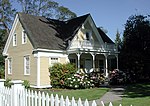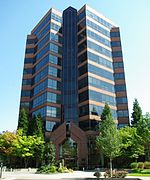Hall/Nimbus station
2009 establishments in OregonBuildings and structures in Beaverton, OregonBus stations in OregonRailway stations in OregonRailway stations in Washington County, Oregon ... and 3 more
Railway stations in the United States opened in 2009Transportation in Beaverton, OregonWES Commuter Rail

Hall/Nimbus is a train station in Beaverton, Oregon, United States, served by TriMet as part of WES Commuter Rail. It is the second station southbound on the commuter rail line, which runs between Beaverton and Wilsonville in the Portland metropolitan area's Washington County. Opened in February 2009, the TriMet-owned station is located west of Oregon Route 217 (OR 217) near the Washington Square shopping mall on Hall Boulevard. It includes a 50-car park and ride and connections to TriMet bus routes 76–Hall/Greenburg and 78–Beaverton/Lake Oswego. WES connects with the Blue and Red lines of MAX Light Rail at Beaverton Transit Center.
Excerpt from the Wikipedia article Hall/Nimbus station (License: CC BY-SA 3.0, Authors, Images).Hall/Nimbus station
Southwest Cascade Avenue, Beaverton Greenway
Geographical coordinates (GPS) Address Nearby Places Show on map
Geographical coordinates (GPS)
| Latitude | Longitude |
|---|---|
| N 45.4582 ° | E -122.7869 ° |
Address
Southwest Cascade Avenue
Southwest Cascade Avenue
97223 Beaverton, Greenway
Oregon, United States
Open on Google Maps









